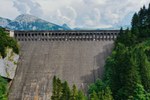News
Point of view: Let’s create an “Alpine Plan” for all Alpine regions!

Whether it is the expansion of renewable energies, settlement development or tourism: the limited space available in the Alpine region must be used sparingly, all while balancing the ecological, social and economic aspects. The mountainous topography of this region sets natural development limits, further exacerbating land use conflicts in comparison to regions outside the Alps: the Alpine region is therefore a particularly contested arena in respect of such conflicts.[1] Alpine spatial planning requires a holistic approach, at best using a comprehensive planning tool. In some Alpine countries, such as Austria, this type of national planning instrument has been lacking so far – although it would be worthwhile to look across the border.
The German state of Bavaria enacted the “Alpine Plan” in 1972. The Alpine Plan is considered a classic spatial planning instrument: it divides the corresponding part of the Alps into three development zones. In this way, the limited Alpine space should be able to accommodate different forms of tourism. Intensive tourism offers (e.g. skiing areas) should be given just as much space as extensive ones (e.g. hiking).
Today, we are no longer only faced with the challenge of tourism development pressure through new ski lifts, ski slopes, snow cannons or reservoirs: user interests in Alpine locations are increasing. Wind turbines and high-voltage power lines on mountain ridges, dams in high valleys, photovoltaic plants on Alpine meadows, transmission masts on summits: climate, biodiversity and energy crises all pose immense challenges for spatial planning in the Alps. This makes it all the more urgent to have an instrument like the “Alpine Plan” that extends beyond the borders of Bavaria and goes further than the question of tourism. This will only be possible through intensive cooperation between sectors and regional authorities at all administrative levels. A spatial development concept for Alpine spatial planning could help here. In Austria, for example, such a concept forms part of the government’s programme, but so far it has not been put into practice. Today, after 50 years, Alpine spatial planning has the chance once again to take on a pioneering role. Let’s seize it!
[1] H. Job, C. Meyer in Handbuch Alpine Raumordnung (2022): Rahmenbedingungen und Herausforderungen des Alpenraumes, CIPRA Österreich



